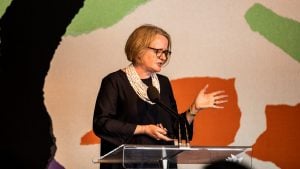Architect, historian and the first RIBA Vice President for Research, Professor Flora Samuel was in Australia recently for the Sydney Architecture Festival to discuss the issues around her impactful book, Why Architects Matter. Flora sat down with Byron Kinnaird for a wide-ranging discussion on the importance of writing and research in architecture, fostering research culture within practice, and how to make institutions more diverse and relevant.

State of the profession
In the UK, the profession is at a real crossroads in its identity and how it responds to changes in technology, and in ethics and diversity. I realised this about eight years ago through education, through being Head of the Sheffield School of Architecture. I came to this work largely because I feel so strongly that we are failing the students coming through. We are failing to prepare them for a good quality of life and good payment, and all the expectations they might have.
That was one of the spurs for me, along with the terrible quality of the built environment in the UK. Perhaps only 10 percent of architecture, of buildings, are made by architects in the UK. Unfortunately, architects get the blame for the other 90 percent.
So, I got into this world of thinking about how practices use their knowledge, and how they express and communicate it. That was really quite contentious at the beginning, when practices didn’t like to talk about research and felt very uncomfortable in that zone. But it’s been amazing. This has been a long burn – not just me – starting with Frank Duffy and people back in the 1960s and ‘70s, who began really trying to push the knowledge base of architects.
I have come to it at a really exciting time, when it has started to hit the top of the professional agenda. There’s been a real transformation and people are comfortable with the idea of research now. It’s right at the top of the strategy of the profession in UK, so we hope it goes somewhere.
Personal trajectories and architectural education
I strongly believe in talking about personal trajectories. It’s really helpful to other people who are trying to situate themselves in the profession.
So, looking back, I really loathed my training. I really, really did. I was very critical of it. I felt like a square peg in a round hole the entire time. I felt very angry about architectural education and came out and tried to be many other things. But I was in housing practice and in domestic practice when I had kids, and having kids was absolutely impossible in architecture, because it was so difficult to work part-time and the presenteeism culture is so strong. I remember breastfeeding my first daughter – I have three – while on the phone to a demanding client on Christmas Eve and thinking this can’t go on. And I’m not married to an architect. Sometimes people manage to hide their childbearing years in a practice CV when they are in partnership. Through that process, I came to teach on a program at Southbank University in London, which was for women getting into architecture. It was a really, really innovative course.
There were a lot of people on the program from ethnic minorities and all kinds of backgrounds, and we were trying support them into education. It made me reflect on my own education. I was trying to teach history, but I was teaching these people the history of a lot of white men. If you read Adolf Loos, for example, he is particularly offensive – but nobody mentioned this to me when I was training. It just wouldn’t do. It brought all my critical concerns into high relief. So, I became more inspired about the teaching side of things. I secured an academic job and developed my career, the research part of my career, through architectural history. I had to do this fast as I am the family breadwinner. The system means it is very difficult to be a practitioner and work in an architecture school. I have done bits of architecture here and there over these years, but it’s particularly hard.
I was the first woman to lead the renowned MArch at Bath, and then I became Head at Sheffield. I was the first woman to have that role. I had been the first woman to lead the design studio in Cardiff, but it was being at Sheffield that really made me reflect on the inadequacies of education. And that’s why I left to start a new kind of architecture school with Lorraine Farrelly at Reading. It’s an architecture school that is very embedded in the construction industry. So far, it’s going really very well.
I made a policy decision to get up close and personal with practice – because I think that very few academics do – and to try and change from within the RIBA. That’s been an amazing journey.
I’m in a very fortunate position between architecture practice and education, but that also makes it hard – that messy world of knowledge exchange doesn’t often count as really rigorous research and we’ve got a lot of work to do with institutions and universities on incentivising working with industry going forward.
I argue that knowledge architecture is a form of architecture. It’s the making of systems and frameworks and leadership, the naming of things and pushing things up the agenda. I think it’s a very interesting moment within the architectural institutions, particularly the work that Peggy Deamer is doing with the Architectural Lobby – setting up as a union, with chapters across the country, in response to professional organisations like the AIA in the States. They were particularly troubled by AIA support of Trump.
Why architecture isn’t unionised is a very interesting question that we don’t discuss very much at all. Maybe it should be. Maybe that way people wouldn’t do architectural work for free.

Rejuvenating the institutions
Unfortunately, very few people get involved in the institutions – and the demography has traditionally been universally old and white. But that’s really changing now. There are people who are really passionate about changing things – and the institutions are big, grinding machines that really have to change. We’re seeing radical transformation at the moment at the RIBA, which is very exciting. There’s been a recognition of the importance of diversifying and all sorts of measures brought in, which has led to a big change in its leadership.
The RIBA is now suggesting things like paying people to be involved in its committees in order to enable young people to participate. Otherwise, young people have to do it in their spare time or on their holiday days; it’s just not fair. So, making it financially feasible is a very important start. But the reaction has been amazing. In the press recently, we’ve had: “Shock, horror. The RIBA President is going to get paid some money”. Well, of course they’re going to get paid some money! Otherwise, how can they do it unless they happen to have a trust fund or be landed very rich? It’s part of the whole malaise about doing work for free.
The RIBA has now got a Vice-President for Young People and Students, which is great. They are trying to change the rules, whereby it is possible the President could be a young person – they could even be a student if they got that activated to get into the role. Having said that, I don’t think the importance of experience should be downplayed. For all the committees there’s now a kind of analysis of the demography of the committees to make sure that they have a good balance of people.
But if I had to do a fix-quick to make the RIBA really, really relevant to the current generation I would get somebody in there to do what the Dutch BNA are doing. I would get somebody in there creating innovation competitions and fostering cross-disciplinary innovation with creative industries and start-ups and all these sorts of areas that we don’t really talk about much in architecture.
An emphasis on innovation would show that the RIBA was incredibly forward-looking, cross-disciplinary and open for discussion. I think that could be a very quick-hit to show that it wasn’t this dusty old institution and that actually times are changing. We are working towards this.
I also think we have to give the people who do these institutional jobs more credit. They are not boring or failed architects or anything like that; they’re people who are very passionate and often very well informed, but they have to be diplomatic.
The title of Architect
I haven’t come to a conclusion about title. I think maybe the title is necessary at this moment, but maybe in the future it could be dismantled once people understand the core skills of the architect, because I think it is getting in the way of some things and it comes with a lot of baggage that does feel excluding to many people – especially if it raises images of Howard Roark and The Fountainhead and those sorts of things. But then the RIBA has recently done some significant work around role-models and promoting different kinds of people from different backgrounds as architects. If people start realising that architects look different to the stereotypes, then maybe that falls apart anyway.
Architects and writing
The architects that I know are very nervous about writing – and students come out of schools feeling unable to write. And you get this kind of waffly archispeak talk that really just turns people off enormously. I’ve seen that as a client advisor. So, we’re really trying to help students be very discerning about different writing modes for different situations, and to understand different voices and what’s appropriate. Particularly in this text-message age, it’s quite a complicated thing to understand what it is to be a professional in modes of writing.
It’s interesting. With the RMIT PhD, they have even talked about writing not being part of a PhD – that you would do a sort of silent art-based PhD. This is an interesting viewpoint. Certainly, I believe that writing is part of the practice of architecture.
I think the students first need to know what research-writing is. We describe it as the ‘Anglophone Social Science style’ in Reading, where I am, which is the basic normative way of describing research, aims, methodology and so on. Students need to know how to do that first and then they can start being creative and playing with other modes and other feminist forms of subjectivity and objectivity and other things. But until they know the bones of the global language of research, they shouldn’t start diving into other things. It’s a bit like Picasso learning how to draw in the classical mode before he starts taking it apart.
Research in practice
Many practices don’t know how to access the best levels of knowledge because they’re hidden away on the Internet – and you have to pay for refereed journals. People aren’t used to working in that way, so we’re trying to encourage students to use the refereed sources and to be discerning about the knowledge sources that they use. I think the biggest barrier for practices is they don’t know how to access funding. This is not difficult. We could just add a button to the website that leads to the funders, so that the regular calls keep coming through.
At the same time, practices need to develop a research trajectory. They need to start off small and get bigger and bigger and bigger. Managing expectations is important, because practices think, I can go straight into some mega-project. But it’s not like that. It’s a long, slow burn developing a research trajectory.
Small practices often believe that they don’t have the money or space to do research, but I have seen really good small practices that do, and they have benefited so much through it. So, I don’t accept that actually. If they’re being paid that little and they’re that strung-out, they shouldn’t be in practice in the first place, you might suggest.
Continuing Professional Development shows that you’re a proficient practitioner. However, I think a lot of the training around this is quite defective at the moment. We are trying to develop CPD that provides research training, access to funding, learning how to write, knowledge management within the practice, those sort of things… Developing the innovation capability of practice. That’s where we’re trying to go with that.

The invisibility of architectural research
In the UK, our research projects are defined and assessed according to OECD definitions of skillsets – and architecture is nowhere to be seen in that. So, if you put in a bid you have a dropdown menu to say, “Where do you sit?” – and you’re nowhere. The institutions have to be lobbying to be visible, but because the institutions haven’t taken the research very seriously, they haven’t bothered to do that stuff.
So, currently you put in your bid and it doesn’t sit anywhere within social sciences, it doesn’t sit in the traditional arts, it doesn’t sit in STEM. It’s really a problem and there’s a lot of work to be done. That’s one of my missions actually – to try to give architectural research a proper chance, because from what I’ve seen, when an architectural bid goes in, the odds are against it just from the people who are going to be in that room.
Being loud and proud about research
Architects have too often borrowed methodologies and ways of working from other fields because they don’t feel confident that they have anything to offer. However, the thing that architects do have to offer is the design studio. This is something that is starting to be borrowed by other fields, such as management. Sometimes it is described as using a boundary object – the model, the drawing or whatever – as the focus of a negotiation, tweaking and discussing and changing it until it becomes an ‘artefact of knowledge’. It’s a methodology for co-produced work. And I think we need to be loud and proud about that and get the message across that that’s what we do and we have that to offer.
Part of my mission has been trying to convince practitioners to replay their own work as research. It’s just a matter of semantics a lot of the time, and it shouldn’t be scary at all.
Architects actually do research all the time. There are different kinds of research that they do, whether it’s research projects or research in product libraries or finding out technical information. There are different categories of research happening in every practice and it needs to be valorised and brought forward. It’s one of the roles of the Research Practice Leads, a group of leaders of research in architectural practice. We have this network working together to try and get that stuff to the front of the table. Certainly, in the UK, those people feel that if there is a recession they’re the first people who are going to be given the sack, but actually our mission is to make them the last people to go.
Harassment and discrimination
In my experience, bullying and discrimination were rife until about ten years ago, and they are still there in some places. If you work in the university context you had to keep quiet about it because you felt you would not get another job. But I think the systems and processes of equity and supporting quality and diversity are really making a difference. Today, practices have really got to shape up. If they’re offering terrible conditions to their staff, making them work all weekend and late at night, they shouldn’t be in existence. We have to be collective. There has to be a collective belief that it’s not acceptable to expect these kinds of levels of work. I do think that basic levels of behaviour in architectural circles have got a lot better.
The business case for behaving decently
We have to work on our ability to listen to each other and to other people, and we don’t valorise that in education very much. Those are the things that need to be cultivated and part of the training.
It’s all wrapped-up with good business actually, because good managers don’t harass and bully people. They must lead from within. They need to listen and be sensitive. This is what it is to be a good manager and leader.
Perhaps we haven’t taken management and leadership seriously enough in the profession because, you know, “There aren’t enough resources for that”. But I’m confident that the highly professional firms I know treat their staff very well and they reap the benefits of retaining good staff. They don’t lose knowledge every time people leave. They promote and value people. There’s a very good business case for behaving decently.
But architecture has this sort of legendary archetype… and I still think that some people applaud the charismatic, sometimes abusive architect leader as a good thing. I hope that’s dying out.
Achievements
In terms of work, the thing I’m most proud of is setting up this network Research Practice Leads, because that’s been such a fruitful thing. It’s been so delightful plugging a gap in the market that’s got a lot of interest in it. And I’m proud of having been Head of Sheffield, because there are very few women high up in academic architecture and it is a very inspiring school and I’m proud of what we are doing at Reading. Nobody ever talks about academic architecture architects because they’re kind of a sub-species to the ‘real’ practice of things. So, I am very proud of being that.
Advice to your younger self
To be yourself really and to make time to reflect and to enjoy yourself and not beat yourself up, because I think you do better work when you are kind to yourself. So, my advice to my younger self, to be kind to myself in order to be kind to others.

Flora Samuel was in Australia to participate in the 12th annual Sydney Architecture Festival from 28 September to 1 October. Our warmest thanks to Byron Kinnaird for conducting the interview for Parlour. Photographs were taken by Tim Horton (Byron and Flora) and Boaz Nothman (Flora on stage).
Flora Samuel is the first elected Vice President for Research at the Royal Institute of British Architects where she has been fighting the cause of research in practice for over five years. An architect and historian, she was the first female Head of the highly ranked University of Sheffield School of Architecture before moving to the University of Reading to help set up a new industry-led architecture school in close collaboration with construction. She is critical of architectural education in its current UK format. Flora is an internationally renowned writer on Le Corbusier, but has more recently turned her attention to the issue of Why Architects Matter (Routledge, 2018), the title of her most recent book. Other publications include Demystifying Architectural Research: Adding Value to your Practice (with Anne Dye, RIBA Publishing, 2015) and a series of reports developed with the RIBA, most notably Building Knowledge: Pathways to Post Occupancy Evaluation (2016).
Byron Kinnaird works at the NSW Architects Registration Board in research and policy. He grew up in Aotearoa New Zealand, studied architecture in Wellington, and is completing a PhD through the University of Melbourne that has investigated the professional education of architects in Australia.
Interview by Byron Kinnaird. Compiled and edited by Susie Ashworth.


















